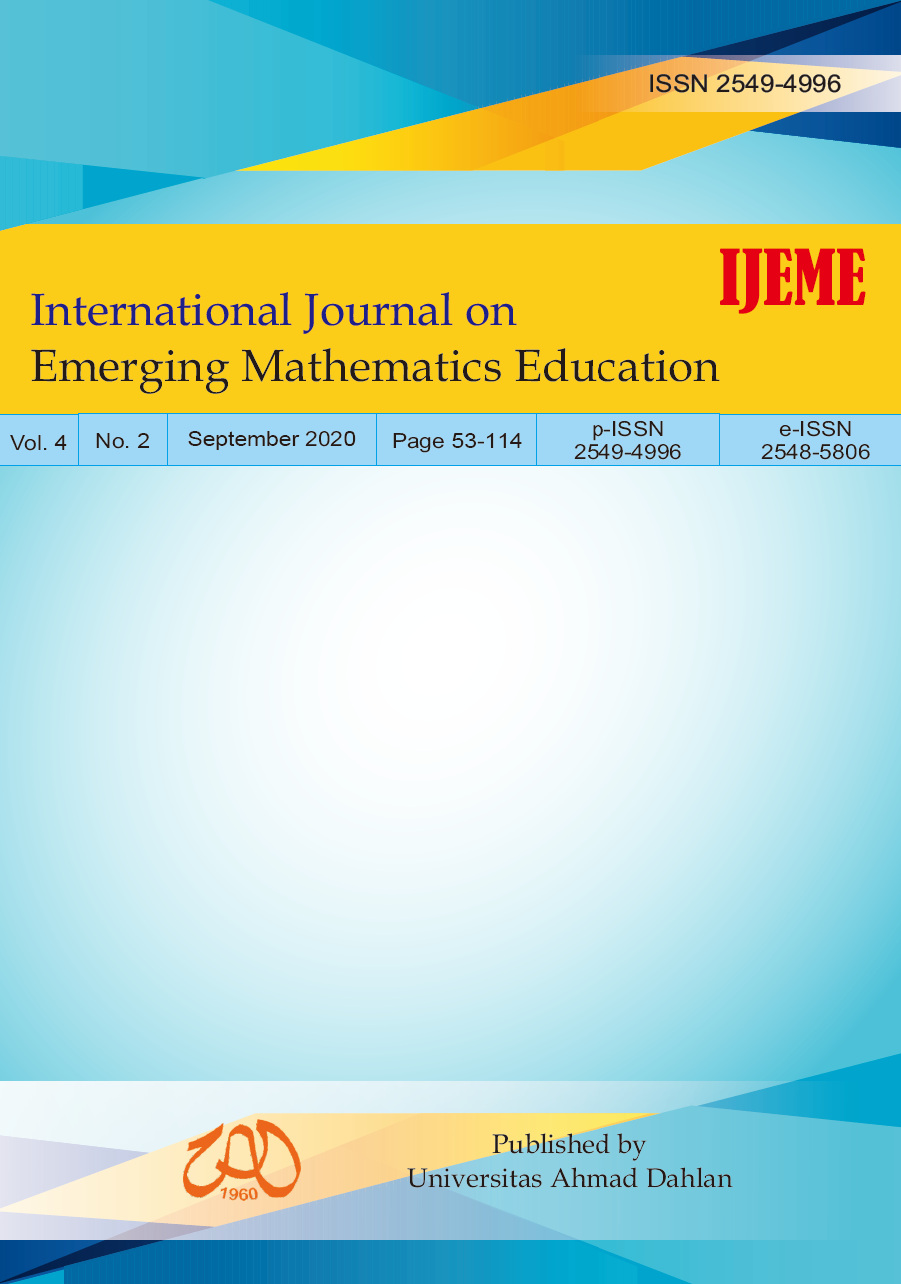Conceptual Understanding of Visualizer and Verbalizer Using Multiple Representation
DOI:
https://doi.org/10.12928/ijeme.v4i2.17767Keywords:
conceptual understanding, multiple representation, cognitive learning styleAbstract
Students’ understanding of function can be seen by their representation of symbols, words, and graphs. Students’ understanding can be determined by considering their choices in defining, giving examples, and presentations of functions from the presentation choices provided for them. This study had used three types of multiple representation which comprised of symbols, words, and graphs to describe students’ understandings of functions. In this descriptive qualitative research, the researchers had classified the subjects based on verbalizer learning style and visualizer learning style. Verbalizer and visualizer learning styles are forms of cognitive learning styles. Both the verbalizer and visualizer’s works were described based on their preferences in representing the given functions. Their works, as well as their response sin the interviews, provided opportunities for the researchers to study their emerging understanding of mathematical concepts. The verbalizer tends to connect her understanding by detail explanation of the given representation. On the other hand, the visualizer tend to connect her imagination from a picture that represents her ideas.
References
Anam, R. S., Widodo, A., & Sopandi, W. (2017). Representation of Elementary School Teachers on Concept of Heat Transfer. In Journal of Physics: Conf. Series (p. 895).
Blazehenkova, O., & Kozhevnikov, M. (2008). The New Object-Spatial-Verbal Cognitive Style Model: Theory and Measurement. Applied Cognitive Psychology, 23(5), 638–663.
Dunn, R., Beaudry, J. S., & Klavas, A. (2002). Survey of Research on Learning Styles. California Journal of Science Education, 2(2), 75–98.
Ginsburg, H. P., & Amit, M. (2008). What is teaching mathematics to young children? A theoretical perspective and case study. Journal of Applied Developmental Psychology, 29(4), 274–285.
Hiebert, J., & Lefevre, P. (1986). Conceptual and procedural knowledge in mathematics: An introductory analysis. In J. Hiebert (Ed.), Conceptual and Procedural Knowledge: The Case for Mathematics, 1-27. Hillsdale, New Jersey: Lawrence Erlbaum
Miles, M.B. & Huberman, M. a. (1994). Qualitative data analysis: An expanded sourcebook (2nd ed.). Qualitative Data Analysis: An Expanded Sourcebook (2nd Ed.)., 20(1), 159–160.
National Council Of Teachers Of Mathematics. (2000). Principles and Standards for School Mathematics. School Science and Mathematics, 47(8), 868–279.
Panasuk, R. M. (2010). Three Phase Ranking Framework for Assessing Conceptual Understanding in Algebra Using Multiple Representations. Education, 131(2), 235–257.
Panasuk, R. M. (2011). Taxonomy for assessing conceptual understanding in Algebra using multiple representations. College Student Journal, 45(2), 219–232.
Setyawan, F. (2017). Profil Representasi Siswa SMP terhadap Materi PLSV Ditinjau dari Gaya Belajar Kolb. Journal of Medives: Journal of Mathematics Education IKIP Veteran Semarang, 1(2), 82-91.
Setyawan, F., & Prahmana, R. C. I. (2017). Visualizer’s representation in functions. In Journal of Physics Conference Series (Vol. 943, No. 1, p. 012004).
Setyawan, F., Prasetyo, P. W., & Nurnugroho, B. A. (2020). Developing complex analysis textbook to enhance students’ critical thinking. JRAMathEdu (Journal of Research and Advances in Mathematics Education), 5(1), 26-37.
Sierpinska, A. (2013). Understanding in Mathematics. Understanding in Mathematics.
Skemp, R. R. (1978). Relational Understanding and Instrumental Understanding. The Arithmetic Teacher, 26(3), 9–15.
Skemp, R.R. (1976). Relational understanding and instrumental understanding. Mathematics Teaching, 77, 20-26.
Skemp, R.R., (1982). The Psychology of Learning Mathematics, Great Britain: Hazell Watson & Viney.
Skemp, R.R. (1986). The Psychology of Learning Mathematics. Great Britain: Penguin.
Wu, C.-C., Dale, N. B., & Bethel, L. J. (1998). Conceptual models and cognitive learning styles in teaching recursion. In Proceedings of the twenty-ninth SIGCSE technical symposium on Computer science education - SIGCSE ’98 (pp. 292–296).
Downloads
Published
How to Cite
Issue
Section
License
License and Copyright Agreement
In submitting the manuscript to the journal, the authors certify that:
- They are authorized by their co-authors to enter into these arrangements.
- The work described has not been formally published before, except in the form of an abstract or as part of a published lecture, review, thesis, or overlay journal. Please also carefully read the International Journal on Emerging Mathematics Education (IJEME) Author Guidelines at http://journal.uad.ac.id/index.php/IJEME/about/submissions#authorGuidelines
- That it is not under consideration for publication elsewhere,
- That its publication has been approved by all the author(s) and by the responsible authorities, tacitly or explicitly, of the institutes where the work has been carried out.
- They secure the right to reproduce any material that has already been published or copyrighted elsewhere.
- They agree to the following license and copyright agreement.
Copyright
Authors who publish with the International Journal on Emerging Mathematics Education (IJEME) agree to the following terms:
- Authors retain copyright and grant the journal the right of first publication with the work simultaneously licensed under a Creative Commons Attribution License (CC BY-SA 4.0) that allows others to share the work with an acknowledgment of the work's authorship and initial publication in this journal.
- Authors are able to enter into separate, additional contractual arrangements for the non-exclusive distribution of the journal's published version of the work (e.g., post it to an institutional repository or publish it in a book), with an acknowledgment of its initial publication in this journal.
- Authors are permitted and encouraged to post their work online (e.g., in institutional repositories or on their website) prior to and during the submission process, as it can lead to productive exchanges, as well as earlier and greater citation of published work.
![]()
Ciptaan disebarluaskan di bawah Lisensi Creative Commons Atribusi-BerbagiSerupa 4.0 Internasional.





